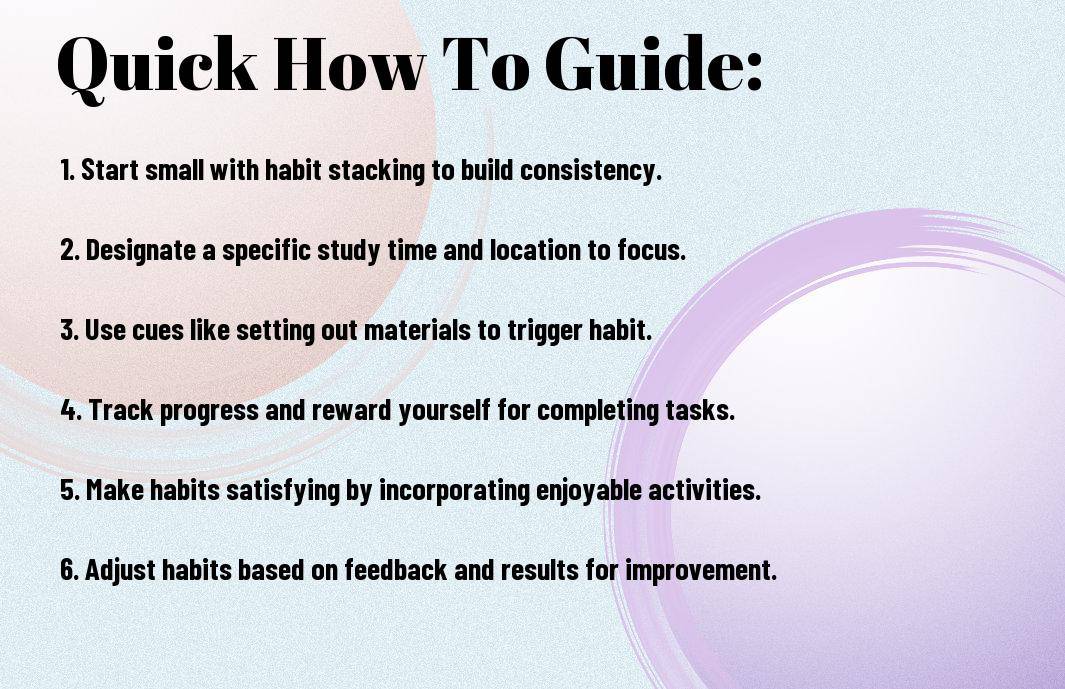Overwhelmed by the demands of school and looking to improve study routines? Let’s look into how incorporating Atomic Habits can make a significant impact on your academic life. These small, consistent changes have the power to revolutionize the way you approach studying, leading to increased focus, productivity, and ultimately better grades. By understanding the principles of Atomic Habits, you can take control of your learning journey and set yourself up for success.
Key Takeaways:
- Start Small: Begin by making tiny changes to your study routine, like setting aside just 10 minutes for reading or reviewing notes.
- Consistency is Key: Develop a study schedule that you can stick to every day, even if it means studying for shorter periods.
- Optimize your Environment: Create a study space that is free from distractions and conducive to learning, such as a quiet corner with good lighting.
- Reward Yourself: Celebrate small wins during your study sessions, whether it’s completing a difficult problem or reaching a milestone.
- Track Your Progress: Use a study planner or app to monitor your study hours, set goals, and see how far you’ve come.
- Stay Accountable: Find a study buddy or join a study group to keep each other motivated and accountable for your progress.
- Continuous Improvement: Continuously tweak and adjust your study habits to find what works best for you, be open to trying new techniques and strategies.

Understanding Atomic Habits
Definition and Fundamentals of Atomic Habits
Any student looking to enhance their study routines can benefit greatly from understanding atomic habits. Atomic habits are small, simple changes or actions that bring about significant results over time. They are the fundamental units of larger habits and can be the key to transforming your academic life.
By focusing on making small improvements consistently, students can gradually build a solid foundation for effective study routines. These tiny changes may seem insignificant at first, but their cumulative impact can lead to remarkable progress and success in academics.
How Atomic Habits Differ from Regular Habits
Habits play a crucial role in shaping our daily lives and behaviors. However, atomic habits differ from regular habits in their approach and impact. While traditional habits often target the outcome or end goal, atomic habits focus on the process and the system surrounding a behavior. Instead of solely fixating on the final result, atomic habits emphasize the small actions taken consistently that lead to long-term improvement.
The beauty of atomic habits lies in their ability to make change manageable and sustainable. By breaking down larger goals into smaller, more achievable steps, students can overcome procrastination and build a habit of consistent progress. These minor adjustments, when practiced consistently, can yield powerful results and transform study routines for the better.
The Four Laws of Atomic Habits for Students
Not long ago, I was reading an insightful article on Atomic Habits in the Classroom: How to Create a Positive Learning Routine and realized how impactful these principles can be for students looking to enhance their study routines.
Making It Obvious: Tips for Creating Cue-Based Study Routines
Laws of atomic habits often revolve around making habits obvious. For students, this means setting up a clear environment that signals when it’s time to study. Using cues like a designated study area, a specific study time, or even a habit tracker app can help reinforce the behavior. Perceiving the cues consistently will make it easier to get into the study mindset.
Making It Attractive: How to Design Alluring Learning Environments
Attractive learning environments can significantly impact a student’s motivation and focus. By incorporating elements that appeal to the senses, such as natural light, plants, inspiring quotes, or colorful stationery, the study space becomes more engaging and enticing for students. An atomic learning environment that is visually appealing can make studying a more pleasant and attractive experience.
Making It Easy: Simplifying Study Sessions for Better Retention
Simplifying study sessions involves breaking down the material into smaller chunks, creating a study schedule, and utilizing effective study techniques like the Pomodoro method. By making the study process more manageable and efficient, students can improve their retention and understanding of the material. Making study sessions easy to navigate helps students stay focused and motivated throughout their learning journey.
Making It Satisfying: Immediate Rewards for Long-Term Growth
To create lasting study habits, students can implement rewards that provide instant gratification for their efforts. For instance, after completing a study session, students can treat themselves to a favorite snack, short break, or a fun activity. By associating studying with positive outcomes, students are more likely to stay committed to their study routines in the long run.
Building Your Atomic Study Routine
Identifying Your Current Habits: The First Step
All students eventually develop study routines, whether they are conscious of them or not. Even the smallest habits can have a big impact on your overall productivity. Start by identifying your current study habits. Do you tend to procrastinate and study only when there’s an upcoming exam? Or do you have a consistent schedule of study sessions throughout the week?
How to Layer New Habits onto Existing Ones
Even if your current study habits aren’t ideal, you can always build on them with new, positive behaviors. Clearly define the new habits you want to adopt and think about how they can fit into your existing routine. For example, if you want to start reviewing your notes before bed each night, you could incorporate this into your bedtime routine.
Step by step, you can begin to layer new habits onto your existing ones. The key is to make these adjustments gradually, so they become ingrained in your study routine over time.
Setting Up Your Ideal Study Space
If you want to optimize your study routine, it’s vital to create an ideal study space. Identifying a quiet, well-lit area with minimal distractions can make a significant difference in your ability to focus and retain information. Make sure your study space is organized and equipped with all the materials you need, such as pens, notebooks, and textbooks.
Overcoming Common Challenges
Staying on Track Despite Distractions
To stay on track with your study routines despite distractions, it’s important to create a designated study space that is free from interruptions. Eliminating distractions such as phones, social media, and noisy environments can help you maintain focus and concentration. Setting specific study goals and using tools like the Pomodoro technique can also help you manage distractions effectively.
Dealing With Procrastination: Strategies for Immediate Action
To tackle procrastination, try breaking down tasks into smaller, more manageable chunks. Setting deadlines and creating a study timetable can help you stay organized and motivated. Additionally, implementing the two-minute rule where you commit to working on a task for just two minutes can help overcome the initial barrier of procrastination.
While it may be tempting to put off studying for later, taking immediate action can help you build momentum and prevent procrastination from derailing your study routine. By acknowledging your procrastination triggers and implementing strategies to address them proactively, you can cultivate a more productive approach to your studies.
Adjusting Your Habits When Life Gets Unpredictable
Life is full of unexpected events that can disrupt your study habits. When faced with unpredictability, it’s important to be flexible and adaptable in adjusting your study routine. Incorporating buffer time in your schedule and prioritizing tasks based on importance can help you navigate through challenges seamlessly.
The key is to not get discouraged by disruptions but rather see them as opportunities to exercise resilience and problem-solving skills. With a positive mindset and a willingness to adapt, you can overcome any obstacles that come your way and continue to make progress towards your academic goals.

The Role of Mindset in Cultivating Habits
Unlike what many people believe, the key to developing effective study habits lies not just in sheer willpower but in the mindset that we approach our tasks with. Our mindset, or how we perceive our abilities and potential for growth, plays a crucial role in shaping our habits and routines.
Growth Mindset vs. Fixed Mindset: Which Fuels Better Habits?
There’s a significant difference between a growth mindset and a fixed mindset when it comes to cultivating habits. A growth mindset thrives on the belief that abilities and intelligence can be developed through dedication and hard work. On the other hand, a fixed mindset perceives abilities as innate traits, leading to a reluctance to challenge oneself and develop new habits.
How to Foster a Positive Attitude for Effective Studying
Now, fostering a positive attitude towards studying is crucial for building sustainable habits. By setting realistic goals, practicing self-compassion, and celebrating small victories, students can cultivate a positive mindset that fuels their study routines. Plus, surrounding oneself with supportive peers and mentors can provide an additional boost of motivation and encouragement.
Measuring Progress and Making Adjustments
Your journey towards developing effective study routines is not just about forming habits but also about tracking your progress, recognizing plateaus, and making adjustments as needed. By being mindful of your study habits, you can ensure continuous improvement and success in your academic endeavors.
Tracking Your Habits: Tools and Techniques
Some effective tools and techniques for tracking your study habits include using habit tracking apps, keeping a study journal, or creating a study schedule. These tools can help you visualize your progress, identify patterns in your study routines, and stay accountable to your goals. Choose a method that works best for you and make it a part of your daily routine to track your habits consistently.
Recognizing Plateaus and How to Overcome Them
Plateaus are common in any habit-building process and can be frustrating. It’s crucial to recognize when you’ve hit a plateau in your study habits – when you feel like your progress has stalled or you’re not seeing improvements in your academic performance. To overcome plateaus, consider changing up your study environment, trying new study techniques, seeking help from a tutor or mentor, or taking a short break to recharge your mental batteries.
The key to overcoming plateaus is to stay patient and persistent in your efforts. Remember that progress is not always linear, and it’s normal to face challenges along the way. By acknowledging plateaus and taking proactive steps to overcome them, you can keep moving forward in your academic journey.
Tweaking Your Habits for Continuous Improvement
The process of habit formation is not set in stone – it requires flexibility and adaptability to suit your changing needs and circumstances. Assuming your study habits are not set in stone, be open to tweaking them for continuous improvement. This could involve adjusting your study schedule, incorporating new study techniques, or setting new goals to challenge yourself.
Understanding that habits are dynamic and evolving can empower you to make meaningful changes that support your academic success. By regularly evaluating your study habits and making adjustments as needed, you can fine-tune your routines and achieve even greater academic outcomes.
Incorporating Atomic Habits Beyond Academia
Applying Atomic Habits to Physical Health and Exercise
For students looking to improve their physical health and exercise routines, the principles of Atomic Habits can be incredibly beneficial. Small changes such as setting a specific time each day for a workout, laying out gym clothes the night before, or starting with just five minutes of exercise can make a big difference over time. By building positive habits gradually, students can see improvements in their energy levels, focus, and overall well-being.
Expanding the Principles to Personal Finance Management
Applying the principles of Atomic Habits to personal finance management can help students develop healthier spending and saving routines. By tracking expenses, setting a budget, or automating savings deposits, students can build financial stability and reduce stress related to money matters.
With consistent effort and small changes, students can gradually improve their financial habits and work towards long-term financial goals.
Cultivating Social Skills and Relationships Through Small Changes
Small adjustments in daily interactions and communication can positively impact social skills and relationships for students. Whether it’s actively listening, sending a thoughtful message, or scheduling regular catch-ups with friends or classmates, these small changes can strengthen connections and enhance social well-being.
Incorporating these small habits into daily routines can lead to more meaningful relationships and a richer social life.
Conclusion
Hence, incorporating atomic habits into study routines can greatly enhance students’ productivity and academic performance. By breaking down tasks into smaller, manageable steps and implementing a routine that aligns with their goals, students can build efficient study habits that lead to long-term success. Consistency and commitment to these small habits will ultimately help students achieve their full potential and excel in their academic pursuits.
FAQ
Q: Why is developing study habits important for students?
A: Developing study habits is crucial for students as it helps them stay organized, be more productive, and achieve better academic results.
Q: How can ‘Atomic Habits’ help students enhance their study routines?
A: ‘Atomic Habits’ provides practical strategies for students to build effective study habits by focusing on small, consistent changes that lead to long-term success.
Q: What are some key principles from ‘Atomic Habits’ that students can apply to their study routines?
A: Students can apply principles such as habit stacking, creating a study environment, setting specific goals, and tracking their progress to improve their study habits.
Q: How can students overcome procrastination when it comes to studying?
A: Students can overcome procrastination by breaking down study tasks into smaller, manageable chunks, using the two-minute rule to get started, and eliminating distractions from their study environment.
Q: How important is consistency in developing study habits?
A: Consistency is key in developing study habits as it helps students establish a routine, build momentum, and make studying a natural part of their daily lives.
Q: How can students stay motivated to consistently follow their study routines?
A: Students can stay motivated by rewarding themselves for small victories, finding a study buddy or support group, visualizing their long-term goals, and celebrating their progress along the way.
Q: What are some practical tips for students to create a study schedule that works for them?
A: Students can create a study schedule that works for them by identifying their peak study times, allocating specific time blocks for each subject, taking breaks in between study sessions, and revising their schedule as needed.
Dive Deeper: Further Explorations for Your Journey
The 10-Minute Rule – A Method to Overcome Procrastination by Starting Small
Learning to Say No – The Importance of Prioritizing Tasks and Commitments
SMART Goals – George T. Doran’s Method for Setting Clear and Achievable Goals
The 2 Minute Rule – David Allen’s (popularized) Trick to Overcome Procrastination and Start Tasks
The Science of Concentration in The Art of Focus



